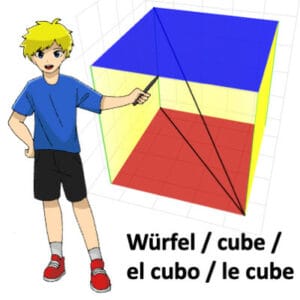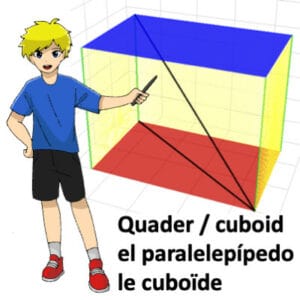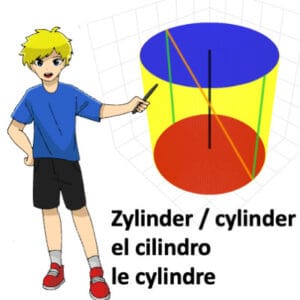Geometrische Körper Übersicht - 3D Ansichten Formeln und Aufgaben
Geometrische Körper Übersicht - 3D Animationen erkunden und Körper verstehen
3D Körper in der Übersicht

Kugel, Kegel, Pyramide in der Geometrie
Geometrische Körper Übersicht
Wir betrachten die folgenden geometrischen Körper:
- der Würfel
- der Quader
- der Zylinder
- das Prisma
- die Kugel
- der Kegel
- die Pyramide
Weitere Infos auch bei Wikipedia:
Würfel 3D - erkunde den Würfel!
Würfel 3D
Der Würfel ist ein besonderer Körper mit 6 gleichen Quadraten als Oberfläche. Alle Kanten stehen aufeinander senkrecht. Der Würfel hat 12 Kanten, die alle gleich lang sind. Kantenlänge nennt man normalerweise a.
Wir haben den Würfen in 3D animiert, damit du selbst alle Ansichten ausprobieren kannst!
Würfel 3D - einfache Animation
Drehe den Würfel und verkleinere oder vergrößere die Ansicht mit der Maus oder den Fingern!
Viele weitere Varianten mit Berechnungen und Eigenschaften findest du auf der Detailseite zum Würfel!
Quader 3D - erkunde den Quader!
Quader 3D - einfache Animation
Zylinder 3D - interaktive Animation, erkunde den Zylinder
Zylinder 3D – einfache Animation
Prisma 3D - interaktiv, erkunde das Prisma
Kegel 3 D - interaktiv, erkunde den Kegel
Kugel 3 D - interaktiv, erkunde die Kugel
Die geometrischen Formen und Körper – Wo braucht man sie?
Das Wissen über geometrische Körper ist in verschiedenen Bereichen der Praxis wichtig und hilft bei der Modellierung, Berechnung und Analyse von Objekten und Strukturen. Hier sind einige Beispiele:
Architektur und Bauwesen: Geometrische Körper spielen eine wichtige Rolle in der Architektur und im Bauwesen. Architekten verwenden das Wissen über diese Körper, um Gebäudestrukturen zu planen und zu entwerfen. Zum Beispiel können sie Quader und Prismen verwenden, um Räume zu modellieren, und Zylinder können bei der Gestaltung von Säulen und Pfeilern verwendet werden.
Design und Modellierung: Das Wissen über geometrische Körper ist auch für Designer und Modellbauer von Bedeutung. Wenn sie Produkte entwerfen oder Modelle erstellen, müssen sie die geometrischen Eigenschaften der Körper berücksichtigen. Zum Beispiel kann die Modellierung eines Autos, einer Skulptur oder eines Industrieprodukts das Verständnis von Körpern wie Kugeln, Zylindern oder Kegeln erfordern.
Ingenieurwesen und Konstruktion: Im Bereich des Ingenieurwesens und der Konstruktion ist das Wissen über geometrische Körper unerlässlich. Ingenieure verwenden diese Konzepte, um Strukturen und Komponenten zu analysieren, zu entwerfen und zu berechnen. Zum Beispiel können sie die Volumina von Tanks oder Rohren (Zylindern) berechnen oder die Tragfähigkeit von Balken (Quader) bestimmen.
Mathematik und Geometrie: Geometrische Körper sind ein wichtiger Bestandteil der Mathematik und Geometrie. Das Verständnis ihrer Eigenschaften und Berechnungsmethoden trägt zum allgemeinen mathematischen Wissen bei. Darüber hinaus werden sie in verschiedenen mathematischen Problemen und Aufgaben verwendet, um Konzepte wie Volumen, Oberfläche, Flächeninhalt, Symmetrie und Transformationen zu veranschaulichen.
Physik und Naturwissenschaften: In der Physik und anderen Naturwissenschaften spielen geometrische Körper eine Rolle bei der Beschreibung und Analyse von Objekten und Phänomenen. Zum Beispiel werden Zylinder und Kugeln verwendet, um die Eigenschaften von Linsen oder Behältern zu beschreiben, und Prismen können bei der Analyse von Lichtbrechung und -dispersion eingesetzt werden.



